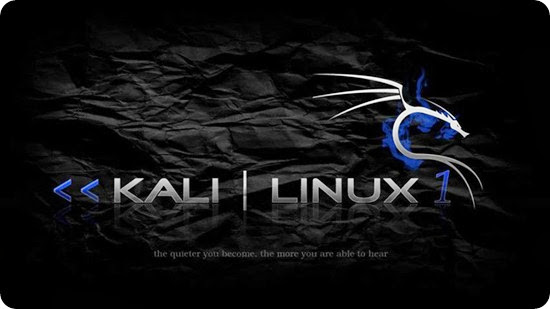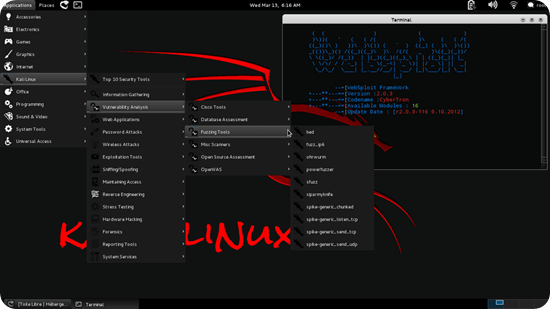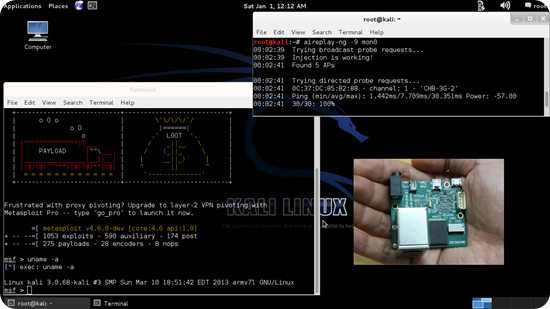Kali Linux is a Debian-derived Linux distribution designed for digital forensics and penetration testing. It is maintained and funded by Offensive Security Ltd. Mati Aharoni and Devon Kearns of Offensive Security developed it by rewriting BackTrack, their previous forensics Linux distribution.
Kali Linux is preinstalled with numerous penetration-testing programs, including nmap (a port scanner), Wireshark (a packet analyzer), John the Ripper (a password cracker), and Aircrack-ng (a software suite for penetration-testing wireless LANs).
Users may run Kali Linux from a hard disk, live CD, or live USB. It is a supported platform of the Metasploit Project's Metasploit Framework, a tool for developing and executing security exploits.
Kali Linux is distributed in 32- and 64-bit images for use on hosts based on the x86 instruction set, as well as an image for the ARM architecture for use on the Raspberry Pi computer and on Samsung's ARM Chromebook.
Kali Linux is the new generation of the industry-leading BackTrack Linux penetration testing and security auditing Linux distribution. Kali Linux is a complete re-build of BackTrack from the ground up, adhering completely to Debian development standards.
Features.
Kali is a complete re-build of BackTrack Linux, adhering completely to Debian development standards. All-new infrastructure has been put in place, all tools were reviewed and packaged, and we use Git for our VCS.
More than 300 penetration testing tools: After reviewing every tool that was included in BackTrack, we eliminated a great number of tools that either did not work or had other tools available that provided similar functionality.
Free and always will be: Kali Linux, like its predecessor, is completely free and always will be. You will never, ever have to pay for Kali Linux.
Open source Git tree: We are huge proponents of open source software and our development tree is available for all to see and all sources are available for those who wish to tweak and rebuild packages.
FHS compliant: Kali has been developed to adhere to the Filesystem Hierarchy Standard, allowing all Linux users to easily locate binaries, support files, libraries, etc.
Vast wireless device support: We have built Kali Linux to support as many wireless devices as we possibly can, allowing it to run properly on a wide variety of hardware and making it compatible with numerous USB and other wireless devices.
Custom kernel patched for injection: As penetration testers, the development team often needs to do wireless assessments so our kernel has the latest injection patches included.
Secure development environment: The Kali Linux team is made up of a small group of trusted individuals who can only commit packages and interact with the repositories while using multiple secure protocols.
GPG signed packages and repos: All Kali packages are signed by each individual developer when they are built and committed and the repositories subsequently sign the packages as well.
Multi-language: Although pentesting tools tend to be written in English, we have ensured that Kali has true multilingual support, allowing more users to operate in their native language and locate the tools they need for the job.
Completely customizable: We completely understand that not everyone will agree with our design decisions so we have made it as easy as possible for our more adventurous users to customize Kali Linux to their liking, all the way down to the kernel.
ARMEL and ARMHF support: Since ARM-based systems are becoming more and more prevalent and inexpensive, we knew that Kali’s ARM support would need to be as robust as we could manage, resulting in working installations for both ARMEL and ARMHF systems. Kali Linux has ARM repositories integrated with the mainline distribution so tools for ARM will be updated in conjunction with the rest of the distribution. Kali is currently available for the following ARM devices:
rk3306 mk/ss808
Raspberry Pi
ODROID U2/X2
Samsung Chromebook
EfikaMX
Beaglebone Black
CuBox
Galaxy Note 10.1
Kali is specifically tailored to penetration testing and therefore, all documentation on this site assumes prior knowledge of the Linux operating system.
The good folks at Offensive Security (who are also the funders, founders, and developers of Kali Linux) have generated alternate flavours of Kali using the same build infrastructure as the official Kali releases. Saying this, these images are considered “unofficial” and will be maintained on a best effort basis by Offensive Security. Do you have an interesting Kali “Recipe build” that you would like to share? Or a Kali image for an interesting ARM platform? Feel free to send us your recipes for inclusion in our contributed images.
Download.
Kali Linux Samsung Chromebook ARM
Build Your Own Kali ISO
Building a customized Kali ISO is easy, fun, and rewarding. You can configure virtually every aspect of your custom Kali ISO build using the Debian live-build scripts. These scripts allow one to easily build live system images by providing a framework that uses a configuration set to automate and customize all aspects of building the image. We have adopted these scripts and use them for the official Kali ISO releases.
Prerequisites.
Ideally, you should build your custom Kali ISO from within a pre-existing Kali environment. However, if this is not the case for you, make sure you are using the latest version of live-build (in the 3.x branch which targets Debian wheezy).
Getting Ready.
We first need to prepare the Kali ISO build environment with the following commands:
apt-get install git live-build cdebootstrap kali-archive-keyring
git clone git://git.kali.org/live-build-config.git
cd live-build-config
lb config
Configuring the Kali ISO Build (Optional).
Through the config directory, your ISO build supports significant customization options, which are well documented on the Debian live build 3.x page. However, for the impatient, the following configuration files are of particular interest:
config/package-lists/kali.list.chroot – contains the list of packages to install in the Kali ISO. You can choose specific packages to be installed, while dropping others. This is also where you can change your Kali ISO Desktop Environment (KDE, Gnome, XFCE, LXDE, etc).
hooks/ – The hooks directory allows us to hook scripts in various stages of the Kali ISO live build. For more information about hooks, refer to the live build manual. As an example, Kali adds its forensic menu this way:
$ cat config/hooks/forensic-menu.binary
#!/bin/sh
cat >>binary/isolinux/live.cfg <<END
label live-forensic
menu label ^Live (forensic mode)
linux /live/vmlinuz
initrd /live/initrd.img
append boot=live noconfig username=root hostname=kali noswap noautomount
END
Building the ISO.
Before you generate your ISO, you can specify your required architecture, choosing either amd64 or i386. Also note that “lb build” requires root rights. If you do not specify an architecture, live build will generate an ISO with the same architecture as the host machine.
If you want to build a 64 bit ISO on a 32 bit Kali system, make sure you enable multi archi support:
dpkg --add-architecture amd64
apt-get update
Configure live-build to generate with a 64 bit or 32 bit ISO:
lb config --architecture amd64 # for 64 bit
# ...or...
lb config --architecture i386 # for 32 bit
lb build
The last command will take a while to complete, as it downloads all of the required packages needed to create your ISO. Good time for a coffee.
Building Kali Linux for older i386 architecture.
The Kali Linux i386 ISO has PAE enabled. If you require a default kernel for older hardware, you need to rebuild a Kali Linux ISO. The rebuilding process is much the same as above, other than the 686-pae parameter that needs to be changed to 486 in auto/config :
apt-get install git live-build cdebootstrap kali-archive-keyring
git clone git://git.kali.org/live-build-config.git
cd live-build-config
sed -i 's/686-pae/486/g' auto/config
lb clean
lb config --architecture i386
lb build
Speeding up future builds.
If you plan to build custom ISOS often, you might want to cache kali packages locally for future builds. This can easily be done by installing apt-cacher-ng, and configuring the http_proxy environment variable before every build.
apt-get install apt-cacher-ng
/etc/init.d/apt-cacher-ng start
export http_proxy=http://localhost:3142/
.... # setup and configure your live build
lb build
Screenshots.
If you liked this article, subscribe to the feed by clicking the image below to keep informed about new contents of the blog:















0 commenti:
Post a Comment